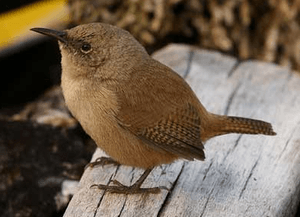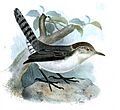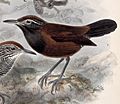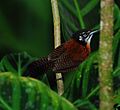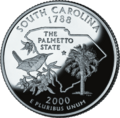Wren facts for kids
Quick facts for kids Wren |
|
|---|---|
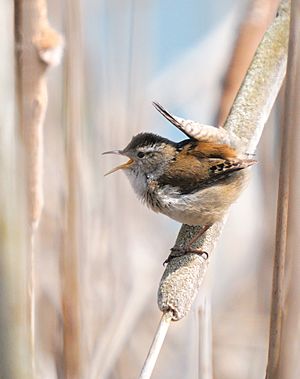 |
|
| Marsh wren (Cistothorus palustris) | |
| Scientific classification |
|
| Kingdom: | Animalia |
| Phylum: | Chordata |
| Class: | Aves |
| Order: | Passeriformes |
| Superfamily: | Certhioidea |
| Family: | Troglodytidae Swainson, 1832 |
| Genera and species | |
|
See text |
|
Wrens are a bird family called Troglodytidae. These small, brown passerine birds are known for their lively nature. There are about 96 different kinds, or species, of wrens, divided into 19 main groups called genera.
Most wrens live in the Americas, from Alaska all the way to Argentina. However, one special kind, the Eurasian wren, lives across Europe, Asia, and North Africa. In English-speaking countries, the Eurasian wren is often simply called "the wren" because it's the bird that gave the name to all the others. Sometimes, the name "wren" is also used for other birds that look similar but aren't actually true wrens, like the New Zealand wrens or Australian wrens.
Wrens are often hard to spot because of their dull colors, but you can definitely hear them! They have very loud and sometimes complicated songs. Some larger wrens, like those in the Campylorhynchus group, are much bolder and easier to see. Wrens have short wings, often with stripes, and they usually hold their tails straight up. They mostly eat insects, spiders, and other tiny creatures. But some wrens also enjoy seeds, berries, and even small frogs or lizards!
Contents
What are Wrens Like?
Size and Appearance
Wrens are small to very small birds. The Eurasian wren is one of the tiniest birds where it lives. Some American wrens are also among the smallest songbirds there. They can be as small as the white-bellied wren, which is less than 10 centimeters (4 inches) long and weighs about 9 grams (0.3 ounces). The largest is the giant wren, which can be about 22 centimeters (8.7 inches) long and weigh almost 50 grams (1.8 ounces).
Their feathers are usually dull colors like gray, brown, black, and white. Many have stripes, especially on their tails or wings. Male and female wrens look very similar, and young wrens look much like the adults. All wrens have fairly long beaks that are either straight or curve slightly downwards.
Wren Songs
Wrens are famous for their loud and often complex songs. Sometimes, a male and female wren will sing together in a duet. Some wrens, like the song wren or musician wren, have songs that sound especially beautiful to us, almost like music!
Where Do Wrens Live?
Wrens are mostly found in the Americas, from Alaska and Canada all the way down to southern Argentina. Many different kinds of wrens live in the warmer, tropical parts of Central and South America. As its name suggests, the Eurasian wren is the only type of wren found outside the Americas, living in Europe, Asia, and northern Africa.
Some wrens live only on islands, like the Clarión wren and Socorro wren in the Pacific, or Cobb's wren in the Falkland Islands. A few Caribbean islands also have their own wrens, such as the Cozumel wren and the very rare Zapata wren found in just one swamp in Cuba.
Wrens live in many different places, from dry areas with few trees to thick rainforests. Most wrens prefer lower parts of their habitats, but some, like the Campylorhynchus wrens, live higher up. The two kinds of Odontorchilus wrens even live only in the very tops of the forest trees! A couple of wrens, like the Eurasian wren and the house wren, often live near people.
Most wrens stay in the same place all year, especially those in Central and South America. But wrens living in colder northern areas sometimes fly south for the winter.
How Do Wrens Behave?
Wrens show many different behaviors. Some wrens, like those in the Microcerculus group, are very shy and hard to see. Others, like the Campylorhynchus wrens, are quite bold and often sing from open spots. Wrens in cooler climates usually live in pairs. But in tropical areas, some wrens live in groups of up to 20 birds!
Wrens build dome-shaped nests. Some pairs stay together for a long time, while in other species, a male might mate with several females.
What Do Wrens Eat?
Generally, wrens are insectivorous, meaning they mostly eat insects, spiders, and other small creatures with exoskeletons. Many wrens also eat plants, like seeds and berries. Larger wrens might even catch small frogs and lizards.
The Eurasian wren has been seen wading in shallow water to catch tiny fish and tadpoles. The Sumichrast's wren and Zapata wren enjoy eating snails. Some larger wrens, like the giant wren and marsh wren, have even been known to eat the eggs of other birds, and sometimes even eggs from their own species! In some Spanish-speaking areas, the giant wren and bicolored wren are called 'chupahuevo,' which means 'egg-sucker,' because of this behavior.
Some wrens, like the plain wren and northern house wren, sometimes destroy other bird eggs. Scientists think they do this to reduce competition for food, not usually to eat the eggs or babies themselves.
Some tropical wrens join groups of different bird species or follow army ants to catch insects that the ants stir up. The Eurasian wren might even follow badgers to find food that the badgers uncover.
The Wren's Name and Legends
The English name "wren" comes from very old English words. It's similar to old words in German and Icelandic.
The wren was also known as the "kinglet" in Old High German. This name is linked to a famous story about how the "king of birds" was chosen. The fable says that the bird that could fly the highest would become king. The eagle flew higher than all other birds, but a tiny bird had hidden in its feathers. When the eagle got tired, the tiny bird flew even higher, winning the title! This story might have originally been about kinglets, which are small birds with yellow "crowns" on their heads. The words for "king" and "kinglet" in ancient Greek were very similar, which might have caused some confusion. This led the title to be transferred to the tiny wren. In modern German, it's called 'Zaunkönig' (meaning 'king of the fence'), and in Dutch, 'winterkoning' ('king of winter').
The scientific name for the wren family, Troglodytidae, comes from the word 'troglodyte,' which means 'cave-dweller.' This is because some wrens like to search for food in dark, hidden places, almost like they're exploring caves!
Different Kinds of Wrens
There are many different types of wrens, each with unique features. Here are a few examples:
- Genus Campylorhynchus
These wrens are often larger and bolder.
-
- Cactus wren (Campylorhynchus brunneicapillus)
- Giant wren (Campylorhynchus chiapensis)
- Bicolored wren (Campylorhynchus griseus)
- Genus Troglodytes
This group includes some of the most well-known wrens.
-
- Eurasian wren (Troglodytes troglodytes)
- House wren (Troglodytes aedon)
- Cobb's wren (Troglodytes cobbi)
- Genus Cistothorus
These wrens often live in grassy or marshy areas.
-
- Marsh wren (Cistothorus palustris)
- Sedge wren (Cistothorus stellaris)
Wrens and People
Wrens have a special place in human culture. The Eurasian wren has long been seen as "the king of birds" in Europe. People used to believe that harming a wren or its nest would bring bad luck, like broken bones or lightning strikes.
Wren Day is celebrated in parts of Ireland on Saint Stephen's Day (December 26th). During this celebration, a fake wren is carried around town on a decorated pole. In the past, real wrens were hunted for this tradition. One possible reason for this tradition is a story that a noisy wren betrayed Saint Stephen when he was trying to hide from enemies.
The Carolina wren (Thryothorus ludovicianus) has been the state bird of South Carolina since 1948. It even appears on the back of South Carolina's state quarter. The British farthing coin featured a wren on its back from 1937 until it was no longer used in 1960. The Cactus wren (Campylorhynchus brunneicapillus) became the state bird of Arizona in 1931.
The Women's Royal Naval Service (WRNS) in Britain were often called "Wrens" because of their acronym. Even though the service was integrated into the Royal Navy in 1993, female sailors are still sometimes unofficially called Wrens.
Images for kids
-
Grey-mantled wren (Odontorchilus branickii)
-
Rock wren (Salpinctes obsoletus)
-
Canyon wren (Catherpes mexicanus)
-
Bewick's wren (Thryomanes bewickii)
-
Black-throated wren (Pheugopedius atrogularis)
-
Happy wren (Pheugopedius felix)
-
Bay wren (Cantorchilus nigricapillus)
-
Long-billed wren (Cantorchilus longirostris)
-
Eurasian wren (Troglodytes troglodytes)
See also
 In Spanish: Troglodítidos para niños
In Spanish: Troglodítidos para niños


